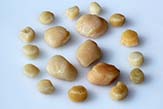Meats and Sausages
Scallops
Shellfish RecipesScallops, Protein-12.06%, Fat-0.49%, Water-82.53%
Scallops are characterized by having two types of meat in one shell: the adductor muscle, called “scallop”, which is white and meaty, and the roe, called “coral”, which is red or white and soft. Outside the U.S., the scallop is often sold whole. In the UK and Australia, they are available both with and without the roe. The roe is also usually eaten. The energy corporation Royal Dutch Shell scallop shell logo is displayed on every gasoline station. The largest wild scallop fishery is for the Atlantic sea scallop (Placopecten magellanicus) found off northeastern United States and eastern Canada. Most of the rest of the world’s production of scallops is from Japan (wild, enhanced, and aquaculture), and China (mostly cultured Atlantic bay scallops).
Scallops are always sold pre-shucked from the shell. They cannot be kept live, because they must scoot around in the water to live.
Processing Your Own Catch
- Turn the scallop so that the darker side of the shelled scallop is facing upwards.
- Take a knife or sharpened spoon and insert it between the top and bottom halves of the shell.
- Force the shell open. Cut away the scallop’s muscle in the top half of the shell and throw the top half of the shell away.
- Clean the inside of the scallop shell of everything but the white muscle.
- Detach the muscle from the shell.
- Rinse the scallop under cold water.
Use herbs, spices, and sauces sparingly so as not to overpower the delicate flavor of the scallops. If you are using them in a chowder, add them last and cook only until they turn white. Large sea scallops will take 3 to 5 minutes in a hot skillet to saute, while the smaller bay scallops will take only 1 to 2 minutes. Overcooking scallops makes them tough and rubbery.
Smoked Scallops
- Brine scallops for 3-5 minutes in 40º brine. (Add 1.0 lb of salt to 1 gallon of water. This makes 40 degrees brine).
- Drain and pat dry. Dip in oil. Drain.
- Preheat smokehouse to 120° F (49° C) and dry the scallops without smoke for 30 minutes.
- Increase temperature to 180° F (82° C) and apply a heavy smoke for 30 - 45 minutes.

















